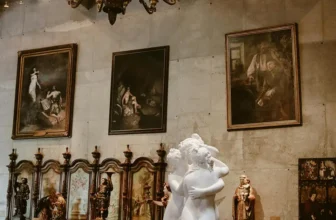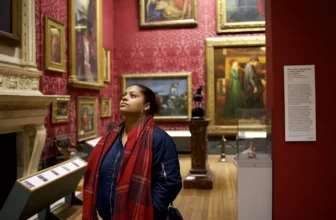The Surreal Slumber: Meaning of Salvador Dalí’s “Sleep” Painting
Salvador Dalí, one of the most enigmatic and revolutionary figures in 20th-century art, continues to bewilder, inspire, and provoke viewers with his surreal masterpieces. Among his rich portfolio of bizarre, dreamlike compositions, Sleep (1937) stands out as a particularly poignant meditation on the fragility of consciousness and the mysteries of the subconscious. This painting is not just a visual anomaly but a deeply psychological work, capturing the delicate boundary between wakefulness and dreams. In this 2000-word in-depth analysis, we will examine the meaning, symbolism, and technique behind Sleep, discuss its historical and artistic context, explore what the painting represents, and reveal where it resides today.
Salvador Dalí and the Surrealist Movement
To understand Sleep, we must first appreciate Dalí’s roots in Surrealism. This artistic and literary movement, which flourished in the early 20th century, sought to unleash the unconscious mind and reconcile it with the conscious world. Inspired by Sigmund Freud’s psychoanalytic theories, Surrealist artists like Dalí, Max Ernst, and René Magritte delved into dreams, free association, and the irrational. Dalí, however, was unique in his method, which he dubbed the “paranoiac-critical method”, a self-induced hallucinatory state used to tap into subconscious imagery.
Dalí’s exploration of dreams and subconscious motifs is particularly evident in Sleep, painted during a tumultuous time in both the artist’s life and in global history.
Historical Context and Background of “Sleep”
Dalí painted Sleep in 1937, a year when Europe was on the brink of World War II and Spain was in the throes of a brutal civil war. Dalí, though often seen as apolitical, was deeply affected by the chaos and violence surrounding him. As political and societal structures disintegrated, Dalí turned inward, exploring themes of mental escape, existential dread, and vulnerability.
The painting emerged as part of a series of works focusing on sleep and dream imagery. It was created during Dalí’s time of reflection in Port Lligat, a coastal town in Catalonia, where he often retreated to escape political tensions and find inspiration in the stark Mediterranean landscapes.
What Is Happening in “Sleep”?
Sleep depicts a massive, disembodied human head suspended in a vast, barren landscape. The head appears to be in a deep slumber, its eyes shut and mouth slack, as if detached from the constraints of the waking world. What immediately stands out is how the head is supported by a series of thin, wooden crutches, a signature Dalí motif.
These crutches prop up various parts of the face: the chin, the nose, the eyes, and even the neck. The presence of these supports implies an unnatural state of rest, suggesting that without them, the head would collapse. The landscape, painted in muted, dreamlike colors, is hauntingly empty save for the shadowy forms and sparse terrain in the background.
Floating in an illogical space with no clear sense of gravity or horizon, the head is enveloped in a surreal stillness that feels both peaceful and disquieting.
Symbolism and Meaning in “Sleep”
Dalí’s Sleep is layered with symbolism, much of which is rooted in Freudian psychoanalysis and the artist’s own obsessions. Below are some of the key symbols and interpretations:
1. The Disembodied Head
The floating head represents the dream state, detached from physical reality. It may symbolize the mind’s journey through the unconscious during sleep, uninhibited by the body or logic. By removing the head from the body, Dalí emphasizes the dominance of the mental and the subconscious during slumber.
2. Crutches
The crutches are perhaps the most iconic element in Sleep. Dalí frequently used crutches in his art to symbolize psychological support systems, artificial strength, or human dependency. In this context, the crutches suggest that sleep is not a naturally stable condition; it requires external props to maintain its illusion of serenity. They imply fragility, the dream world is delicate, and consciousness is a precarious construct.
3. Desolate Landscape
The barren landscape echoes the psychological emptiness or stillness of deep sleep. There are no people, no structures, no signs of civilization. It represents the void of consciousness, where rational thought is suspended, and the mind roams freely.
4. Closed Eyes and Slack Mouth
These features convey the vulnerability of the sleeping figure. With senses dulled and defenses lowered, the figure is at the mercy of dreams and the unconscious. It also suggests a metaphorical “death”, a temporary retreat from reality and life.
5. Muted Color Palette
The use of blues, grays, and soft earthy tones evokes a twilight or dreamlike atmosphere. This subdued palette reinforces the quietude of the sleep state and the surreal ambiguity that permeates the painting.
The Psychological Dimension of “Sleep”
In Sleep, Dalí delves deep into psychological terrain, tapping into the Freudian model of the human mind. Freud postulated that dreams were the “royal road to the unconscious,” a theory that profoundly influenced Dalí. In this painting, Dalí does not depict a dream per se, but rather the condition that allows dreams to emerge, sleep.
The painting can be seen as a metaphor for the human condition: our constant need for escape, restoration, and self-delusion. The crutches may also symbolize the psychological mechanisms, repression, denial, fantasy, that support the mind during unconscious states. Without them, the head (or consciousness) might collapse under the weight of its own thoughts and fears.
Furthermore, Sleep speaks to Dalí’s personal fears, particularly his fear of death and loss of control. The disembodied, helpless head hints at mortality, vulnerability, and the thin veil separating life from death.
Style and Technique: What Type of Art is “Sleep”?
Sleep is a quintessential example of Surrealism, the art movement that Dalí helped popularize. Surrealist art is characterized by dream imagery, irrational juxtapositions, and a hyper-realistic technique used to depict unreal scenarios. Dalí’s work is especially known for its paradox: he uses precise, classical methods to paint illogical, dreamlike scenes.
Dalí’s technique in Sleep showcases his mastery of realistic detail, especially in rendering the skin texture and the wooden crutches. He employs chiaroscuro (the play of light and shadow) to create volume and depth, lending a three-dimensional quality to the floating head. The background is executed in a soft, blurred style that enhances the dreamlike mood.
The surreal quality of Sleep lies not in its painterly execution but in its concept. Dalí challenges the viewer’s understanding of space, anatomy, and logic, constructing a scene that could only exist in the realm of dreams or the unconscious.
Who Painted “Sleep” and How?
Salvador Dalí painted Sleep in 1937, using oil on canvas. As with many of his works from the late 1930s, he was working alone in semi-isolation, using a mix of classical oil-painting techniques that he admired from Renaissance and Baroque masters. Dalí meticulously layered glazes to create luminous skin tones and haunting shadows. His surreal compositions often started as sketches or automatic drawings, inspired by dreams, paranoia, or spontaneous thoughts, which he then refined over days or weeks.
Dalí’s creative process for Sleep likely involved a combination of lucid dreaming, free association, and conscious aesthetic choices. He was known for using what he called the “paranoiac-critical method”, a self-induced trance-like state in which he would generate irrational images and forms, then render them with extreme precision.
What Does “Sleep” Represent?
At its core, Sleep is a visual poem about the human psyche. It represents the tenuous nature of reality, the fragility of consciousness, and the deep mysteries of the dream world. More than just a painting of a person sleeping, Sleep is an allegory for the human condition in its most vulnerable, introspective state.
Some interpret the painting as a critique of escapism, how we prop up illusions to avoid confronting harsh realities. Others view it as a celebration of the unconscious, where creativity and raw emotion thrive unfiltered. Still, others see it as a philosophical statement on death and rebirth, with sleep as a metaphorical rehearsal for the afterlife.
The Current Location of “Sleep”
Today, Sleep is housed in the Yale University Art Gallery in New Haven, Connecticut, USA. The painting is part of the gallery’s permanent collection and is considered one of the highlights of its modern art holdings. It continues to attract art lovers, students, and scholars who seek to understand Dalí’s psychological complexity and technical genius.
The Enduring Legacy of “Sleep”
Salvador Dalí’s Sleep is more than a painting, it is a dream made visible, a study in vulnerability, and a masterful orchestration of symbolism and technique. Through this surreal composition, Dalí invites viewers to contemplate the mysteries of the mind, the illusions of stability, and the paradox of escape through sleep.
Eighty years after its creation, Sleep remains eerily relevant. In a world still grappling with anxiety, disconnection, and the search for inner peace, Dalí’s sleeping head serves as both a mirror and a warning. We, like the head, are often suspended between realities, held aloft by the fragile crutches of belief, memory, and hope.
In the silent slumber of Sleep, Dalí captures the essence of Surrealism: the unlocking of a deeper, often darker truth, hidden just beneath the veil of consciousness. Through its dreamlike detachment and psychological insight, Sleep continues to whisper secrets from the world of dreams, reminding us of how close, and how fragile, the line between waking and dreaming truly is. image/ wikiart




